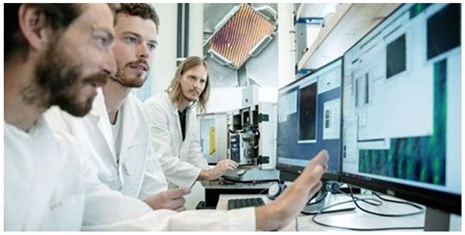|
NOVIDADES
“We found a completely new way to control the conductivity of materials at nanoscale,” says Professor Dennis Meier at the Norwegian University of Science and Technology's (NTNU) Department of Materials Science and Engineering. One of the best aspects of the new method is that it does not interfere with other properties of the material, like previous methods did. This makes it possible to combine different functions in the same material, which is an important advance for nanoscale technology. An enthusiastic Professor Meier says, “What’s really great is that this project is being run from NTNU and involves people from several departments. We also benefit from key facilities like the NanoLab and the TEM (transmission electron microscopy) Gemini Centre. This interdisciplinary approach shows what we can do when we work together.” A new article in the prestigious and influential journal Nature Materials ("Conductivity control via minimally invasive anti-Frenkel defects in a functional oxide") addresses the findings. The first authors are Donald M. Evans, Theodor S. Holstad, Aleksander B. Mosberg and Didrik R. Småbråten, who carried out innovative experiments and simulations in the Department of Materials Science and Engineering and the Department of Physics. The article has attracted international attention even before being printed.  Materials Science and Engineering at the Norwegian University of Science and Technology. Image: Geir Mogen/NTNU
The researchers have managed to create such defects themselves, thus enabling an insulating material to become electrically conducting. Defects in the material are related to its various properties. However, the anti-Frenkel defects can be manipulated in such a way that changes in the conductivity do not affect the actual structure of the material or change its other properties, such as magnetism and ferroelectricity. “Maintaining the structural integrity makes it possible to design multifunctional devices using the same material. This is a big step towards new technology on a nanoscale,” says Meier. The research team includes Professor S. M. Selbach from the Department of Materials Science and Engineering, Professors Antonius T. J. van Helvoort and Jaakko Akola and Associate Professors Per Erik Vullum and David Gao from the Department of Physics, and Associate Professor Jan Torgersen from the Department of Mechanical and Industrial Engineering. “Maybe we’ll be able to use our electronic gadgets longer instead of recycling them or throwing them away. We can just upgrade them instead. This is fundamentally much more environmentally friendly,” Meier says. Planning is already underway for further attempts to combine different components. This work will be carried out by the FACET group at NTNU’s Department of Materials Science and Engineering. The Norwegian University of Science and Technology. Posted: Nov 19, 2020.
|
|||||||||||||||||||||||||